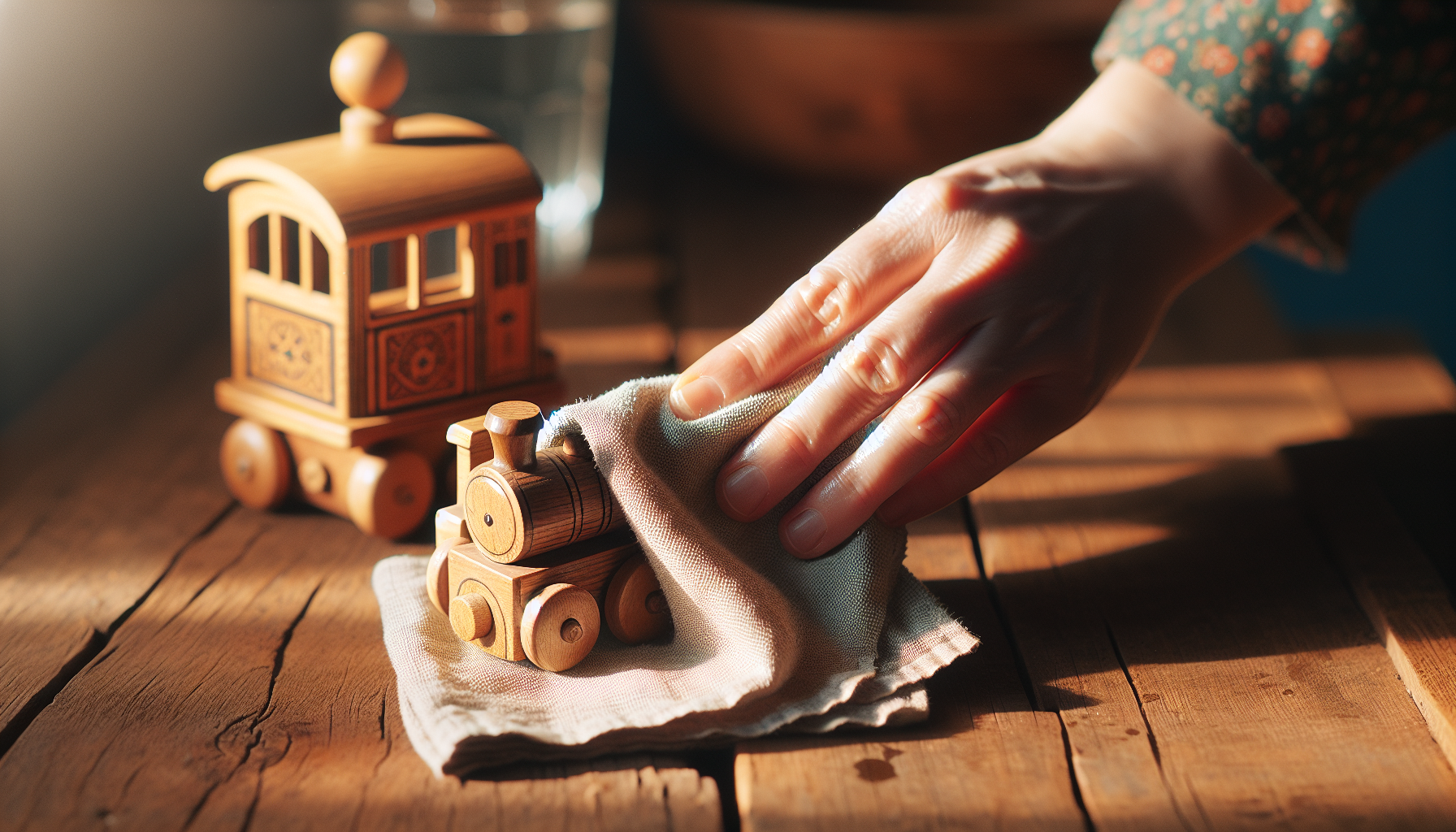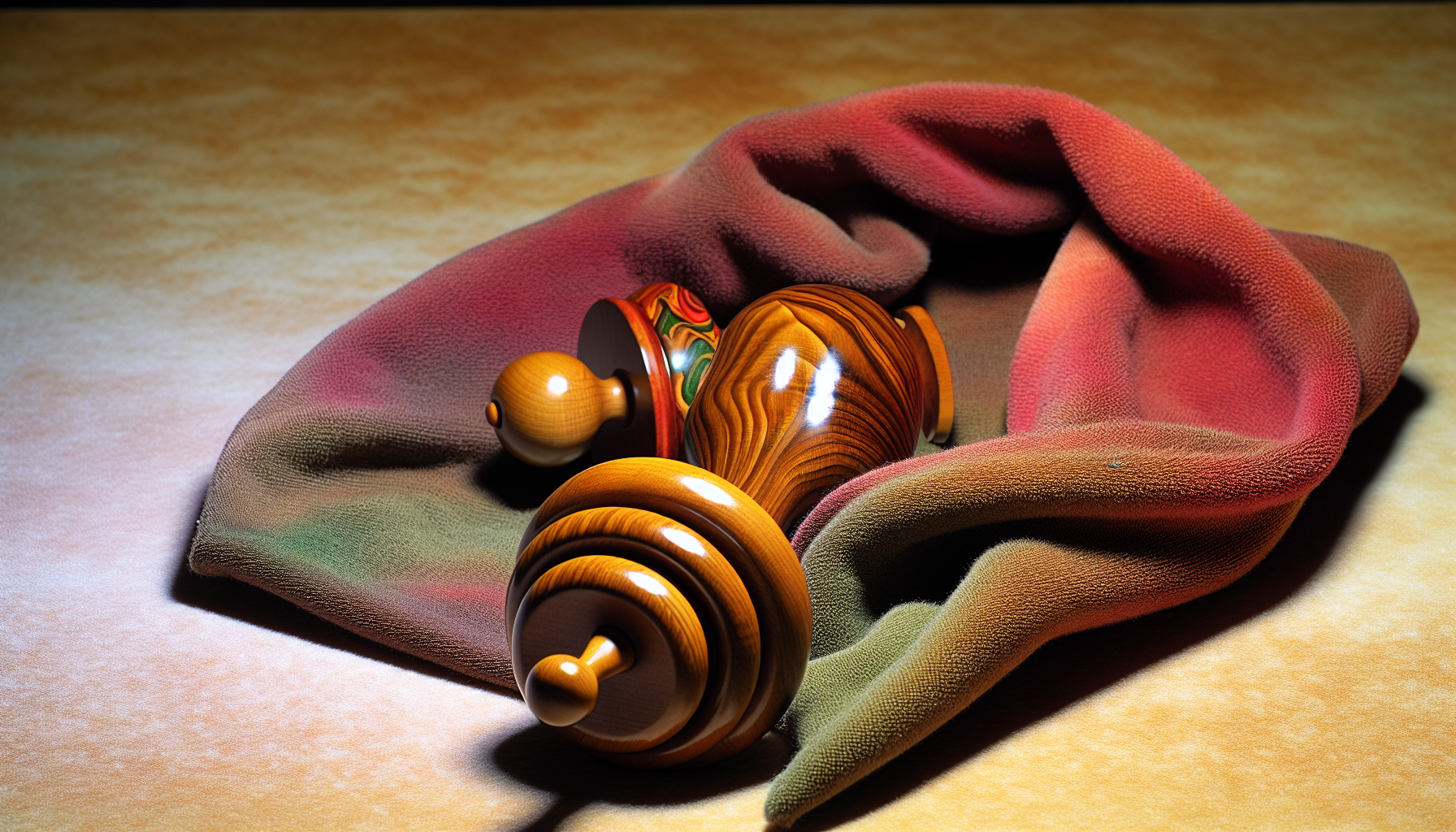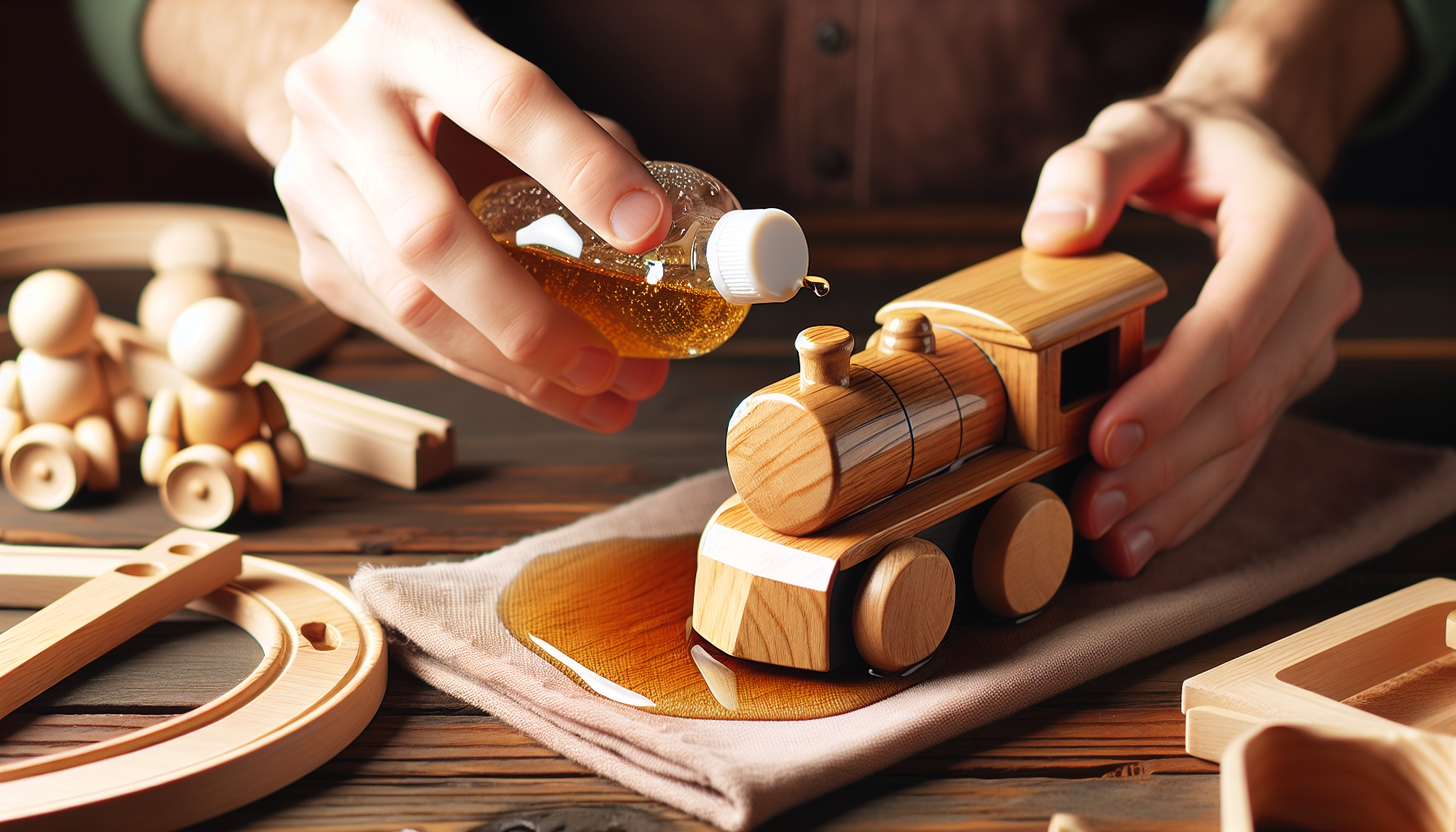Top Tips on How to Clean Wooden Toys
Looking to clean wooden toys without causing damage? Our guide on how to clean wooden toys gets straight to the point, offering quick and child-safe methods. Discover the best eco-friendly ways to get rid of grime and germs, ensuring your wooden toys stay clean and durable for endless playtimes.
The Importance of Cleaning Wooden Toys

Have you ever considered the reason behind the warm, inviting glow of wooden toys that compels you to pick them up and play? It’s not only because they’re beautifully crafted; it’s also because wood, as a material, possesses naturally antibacterial properties. That’s right, your wooden blocks and toy cars are nature’s own germ fighters, making wooden toys hygienic! However, even superheroes need some assistance to maintain their powers at peak performance. That’s where you come in with your reliable ally: the cleaning solution.
Cleaning wooden toys isn't just about wiping away dirt; it's about maintaining a hygienic play environment for your little ones. Kids love exploring by putting toys in their mouths, so cleaning wooden toys regularly helps remove any germs they may have picked up. When you clean your wooden toys, remember you're not just a parent or caregiver - you're a protector of playtimes!
Natural Antibacterial Qualities of Wood
Wooden toys are like natural superheroes, fighting germs with their antibacterial powers. The secret lies in wood's unique qualities. Wood is porous and absorbs moisture, which bacteria need to survive. When bacteria encounters wood, the moisture is drawn away, leaving them dehydrated and defeated. It's like a superhero movie for toys, where the bad guys (bacteria) meet their end!
Even though natural wooden toys have their defenses, they still need a little help from their sidekick – you. So, grab your eco-friendly utility belt of cleaning tools, and let's keep those wooden treasures both clean and safe for all the little superheroes at home.
Hygiene and Child Safety
Kids have a way of turning anything into a mouth toy - whether it's the dog's chew toy, their own foot, or even their actual toys. While this is all about sensory exploration and learning, it also means that toys, wooden ones included, can become germ highways. Regularly cleaning wooden toys becomes a must, especially if they're often in tiny mouths or handled by kids feeling under the weather. So, how often should you clean those wooden toys?
There's no strict rule here, but it's smart to give those wooden toys a good clean if they've been in your little one's mouth a lot or after a sickness. Keep an eye out for any dirt buildup to know when it's time for a scrub. Remember, it's not just about appearances; it's about making sure the toys are safe for your kids to enjoy.
Eco-Friendly Cleaning Solutions for Wooden Toys
Realizing the significance of cleaning wooden toys, let's now shift our focus to the method. The great news is, you don't need harsh, chemical-laden cleaners for cleaning wooden toys. Opting for simple, eco-friendly solutions can be just as effective, if not more. They're kind to the environment and safe for your little ones, making them the perfect choice for cleaning wooden toys.To ensure your wooden toys are clean and safe for your little ones to play with, you can mix up a cleaning solution right in your kitchen using vinegar and water. If vinegar isn't on hand, mild dish soap or castile soap will do the trick. This way, your children can have a blast without any worry about harmful residues. Time to don your apron and dive into the world of eco-friendly cleaning solutions!
Vinegar and Water Solution
Vinegar and water make a fantastic eco-friendly cleaning solution for wooden toys. It’s easy to prepare, and the best part is, it’s non-toxic and gentle on wooden surfaces. To create this magic potion, all you need to do is mix 1 part vinegar with 10 parts water. You can use either white vinegar or apple cider vinegar; both work wonderfully to clean wooden toys.
The vinegar and water solution can be safely used on different types of wooden toys, including those with painted surfaces. So, whether it’s a painted wooden dollhouse or a simple wooden teether, you can use this solution with confidence. Just remember to apply the solution with a soft cloth and avoid soaking the wooden toys to maintain their shape and color.
Mild Dish Soap
If you’re not a fan of the strong smell of vinegar, or if you’ve run out of it, don’t worry. There’s another household item you can use to clean wooden toys – mild dish soap! When diluted with warm water in a spray bottle, it serves as a safe and effective alternative cleaner.
To prepare this mild cleaner, mix eco-friendly dish soap with warm water in a ratio of 1 part soap to 4 parts water. This solution is gentle on the toys but tough on grime.
Baking Soda
For more stubborn dirt, prepare a paste of baking soda and water, and gently scrub the toy with a damp cloth. This mild abrasive is perfect for tackling those pesky spots without damaging the wood's surface. Remember, your aim is to clean the toys, not soak them, so use this solution sparingly.
Apply the paste using a soft brush or cloth in gentle, circular motions to lift the dirt. Once the dirt is loosened, wipe the area clean with a slightly damp cloth to remove any residue of the baking soda paste, ensuring that the toy's surface is left pristine and unharmed.
Castile Soap
Stepping away from kitchen staples, let’s venture into the world of eco-friendly cleaners with castile soap. Derived from vegetable oils, castile soap is a safe, non-toxic, and gentle cleaning option for wooden toys. Plus, it’s free from synthetic fragrances, dyes, and preservatives, making it a great choice for the eco-conscious toy cleaner.
To create a mild cleaning solution for your wooden toys, simply mix castile soap with water in a 1:4 ratio. Apply the solution to a soft cloth and gently wipe the wooden toys to remove dirt and grime. Watch as your wooden toys regain their natural beauty and shine.
Proper Cleaning Techniques for Wooden Toys

Equipped with your eco-friendly cleaning solutions, it’s time to proceed to the actual cleaning process. Before you get started, bear in mind that the cleaning process for wooden toys varies from that of plastic ones. Wooden toys require a bit more care to maintain their integrity.
Start by dusting off the wooden toys. This simple step goes a long way in maintaining their appearance and preventing grime build-up. Once dusted, use your chosen cleaning solution (remember, no toxic cleaners like bleach or alcohol) and gently clean the toys without soaking them. After washing, let the toys air dry completely to preserve their shape and prevent warping. And of course, avoid using dishwashers or washing machines for cleaning wooden toys, unless you’re aiming for a modern art installation rather than a plaything.
Avoid Soaking in Water
We cannot stress this enough: wooden toys require a cleaning method that is not a soak in water. Wood is porous, and when soaked, it can swell, distort its shape, and lose its color. Prolonged immersion can also lead to water damage, compromising the toy’s structural integrity and your child’s safety.
Instead of submerging, use a soft cloth dampened with your mild cleaning solution to clean the toys. This way, you effectively clean the toys without causing any damage. Remember, when it comes to cleaning wooden toys, the motto is: less is more!
Gentle Wiping with Damp Cloth
Cleaning wooden toys is not about vigorous scrubbing; it’s about gentle care. Here are some tips for cleaning wooden toys:
-
Use a damp cloth to wipe down the toys.
-
Avoid using harsh chemicals or soaking the toys in water.
-
After sanding wooden toys, use a damp cloth to remove any dust.
Remember, gentle care is key when cleaning wooden toys, especially when dealing with dirty toys. To wash wooden toys, use a soft cloth and mild soap.
Eliminating dust residues with a damp cloth ensures the toy’s surface is clean and safe for children’s use. Gently wipe the toy with a damp cloth without soaking it to effectively clean the surface. Keep a soft, clean cloth handy, and your wooden toys will be clean and ready for the next playtime in no time.
Air Drying and Sun Exposure
After a gentle wipe down, it’s time for the wooden toys to dry. Air drying is the way to go here. Place the toys in an area with good air circulation and away from direct heat sources. If it’s a warm, sunny day, feel free to let them bask in the sunlight. Sunlight not only speeds up the drying process but also acts as a natural disinfectant.
However, remember that excessive sunlight can cause damage such as warping or cracking, especially in varnished wooden toys. So, a little sunbathing is good, but don’t leave your wooden toys out for a tan! Once the toys are completely dry, wipe them down with a clean, dry cloth and they’re ready for the next adventure.
Caring for Varnished and Painted Wooden Toys

Varnished and painted wooden toys have a special charm. The glossy finish, the vibrant colors – they’re a delight to play with. But they also require special care to maintain their beauty. Proper environmental conditions play a key role in preserving the appearance and longevity of these toys.
Varnished toys should be stored away from harsh sunlight and moist environments to prevent the varnish from fading or the wood from cracking. Similarly, exposure to extreme temperatures can cause wooden toys to warp or crack, so it’s important to avoid such conditions. And since varnished toys already have a protective coating, they typically do not require additional moisture replenishment.
Cleaning Varnished Toys
Cleaning varnished toys might seem like a big job, but it's not much different from cleaning regular wooden toys. The key is to take a gentle approach. The varnish on the toys acts as a protective layer, which makes them less likely to gather bacteria. That doesn't mean they don't need a good clean, but you can do it a bit less often.
To tidy up varnished toys, just follow the same steps as you would for regular wooden toys. Brush off the dust, wipe them down with a mild cleaning solution using a soft cloth, and let them air dry. Just remember not to leave them in direct sunlight for too long to stop the varnish from fading.
Preserving Painted Toys
The beauty of painted wooden toys is truly captivating. The vibrant hues ignite a child's imagination, adding an extra spark to playtime. Yet, caring for these colors requires a touch of extra attention. Direct sunlight can strip the paint off wooden toys, dimming their visual charm.
To preserve the vivid colors and shield the painted surface, it's wise to steer clear of direct sunlight, especially post-cleaning. Following a wash, let the painted wooden toys air dry in a shaded spot away from direct sunlight to safeguard against fading.
By following these steps, your painted wooden toys will remain lively and bright for countless play sessions ahead.
Maintaining Wooden Toys in Good Condition

We’ve covered the importance of cleaning wooden toys as well as the cleaning process. But how do we keep them in good condition for the long haul? After all, well-maintained wooden toys can have a significantly extended lifespan, proving to be a durable and sustainable choice for play.
The first step is to protect wooden toys from warping or cracking. Here are some tips:
-
Avoid exposing them to excessive heat or direct sunlight
-
Choose a cool, shaded location for air drying
-
Regularly inspect wooden toys for any signs of moisture damage or mold
Following these steps will help maintain the condition and safety of your wooden toys.
Let’s explore various methods to keep your wooden toys in pristine condition.
Moisturizing with Non-Toxic Oils
Moisturizing wooden toys with non-toxic oils is a great way to keep them looking their best and prevent the wood from drying out. It's like giving your toys a little spa treatment to maintain their natural beauty! Some good options for moisturizing wooden toys are:
-
Tung oil
-
Raw linseed oil (flaxseed oil)
-
Walnut oil
-
Stand oil (polymerized linseed oil)
These oils, like olive oil, not only hydrate the wood but also form a protective layer, boosting the toy’s durability. Apply them sparingly with a soft cloth, ensuring the toy dries completely before use. Remember, less is more here, so use these oils sparingly to preserve the natural beauty of your wooden toys.
Smoothing Rough Edges with Sandpaper
Over time, wooden toys might develop rough edges or splinters that could be risky for kids. Sandpaper can be your best friend in such cases. Start by using 80 grit sandpaper to smooth out major scratches or gouges.
After the initial sanding, move on to finer grits up to 320 for a polished surface. For a softer touch, try 400 grit sandpaper folded twice to gently sand the outer edges. A little sanding can help keep your wooden toys smooth and safe for your little ones.
Preventing Mold and Mildew
A damp environment is a breeding ground for mold and mildew. To prevent these unwanted guests from invading your wooden toys, follow these steps:
-
Store them in a dry, cool place away from direct sunlight and moisture.
-
Regularly inspect the toys for any signs of moisture damage or mold.
-
Address any issues promptly to maintain their condition and safety.
If you live in an area with high humidity, consider using a dehumidifier in the storage area to maintain a dry environment. This extra step can go a long way in preserving the longevity of your wooden toys and keeping them safe for your children to play with.
Summary
We've taken a whirlwind journey into the world of wooden toys, delving into the significance of cleaning, eco-friendly solutions, and proper care techniques for these cherished playthings. It's not just about keeping them looking good; it's about ensuring they're safe for our kids and preserving their natural antibacterial properties. So, armed with this newfound knowledge, let's keep our wooden toys clean, safe, and ready for all the make-believe adventures ahead!
Frequently Asked Questions
Do wooden toys need to be sanitized?
No need to stress about sanitizing wooden toys - their natural antimicrobial properties make them less susceptible to germs. Just give them a quick clean if your little one has been feeling under the weather or loves to chomp on them.
Are wooden toys self cleaning?
Wooden toys are self-cleaning to some extent because wood is naturally antimicrobial. You'll only need to clean them when your child has been sick or when there's noticeable build-up of dirt or mystery substances (because #toddlerlife).
Is it recommended to soak or immerse wooden toys in water?
No way! Soaking or immersing wooden toys in water is a big no-no, unless you want your toys to turn into abstract art pieces. Trust me on this one!




